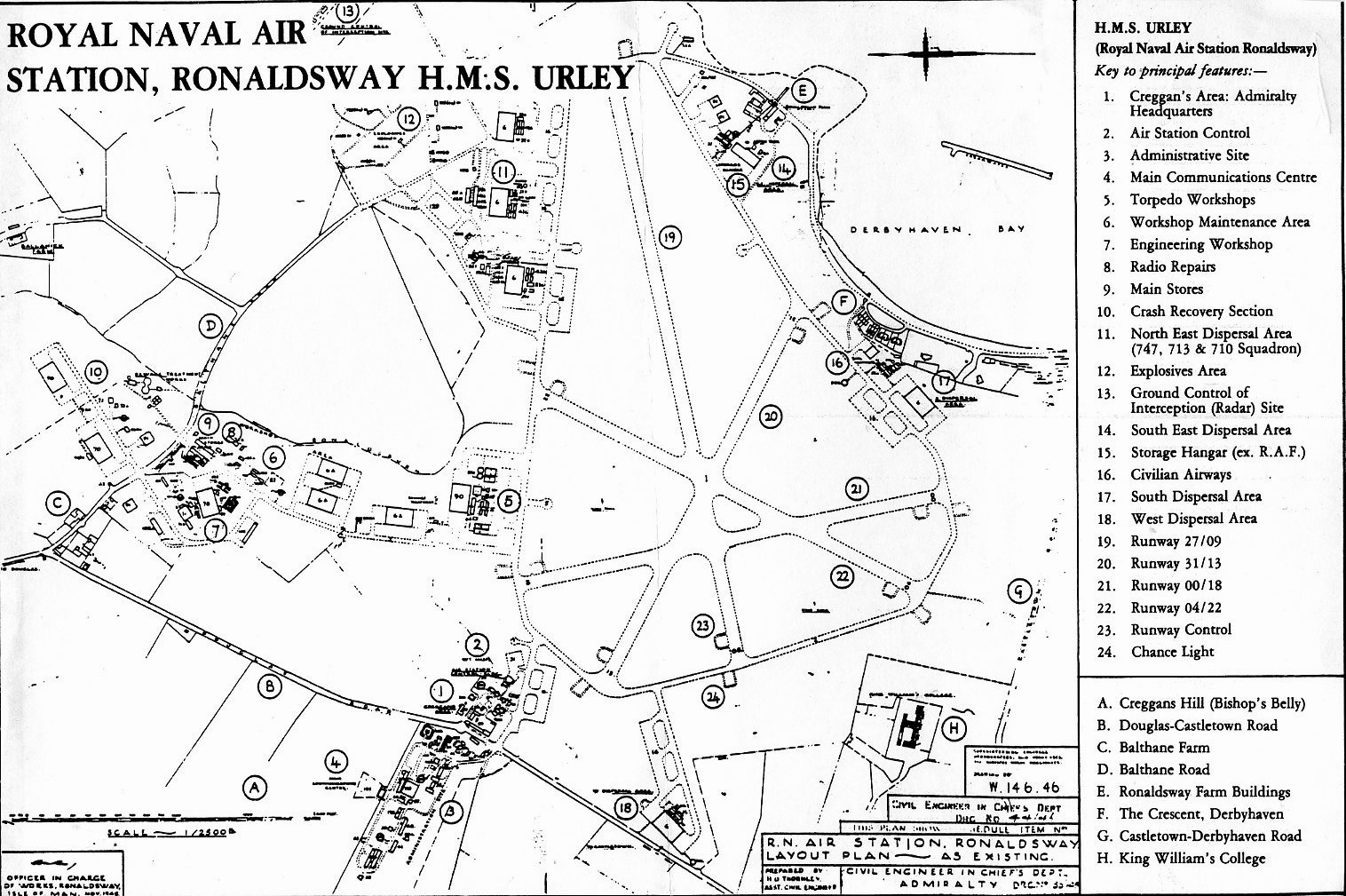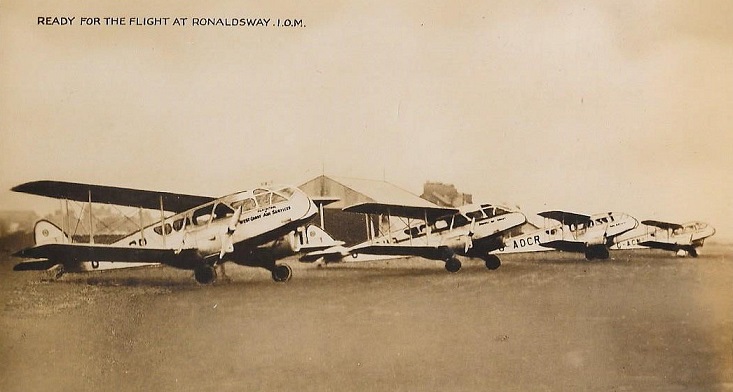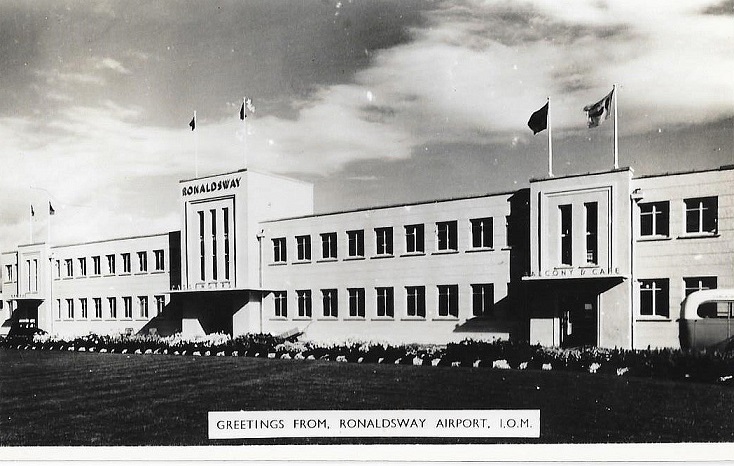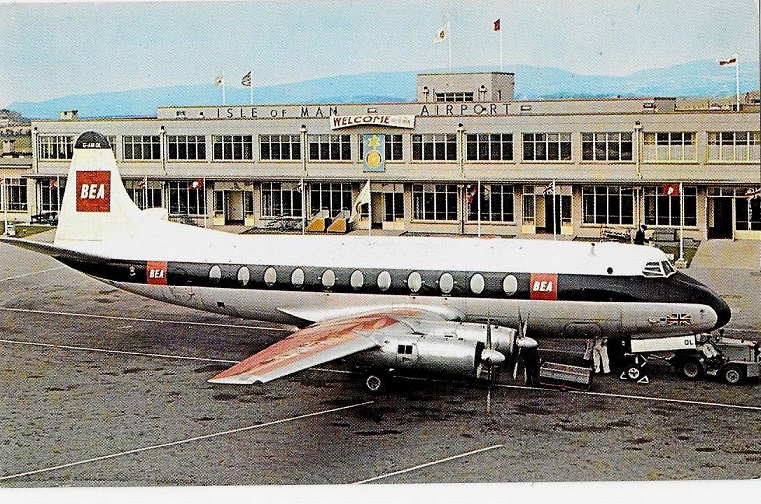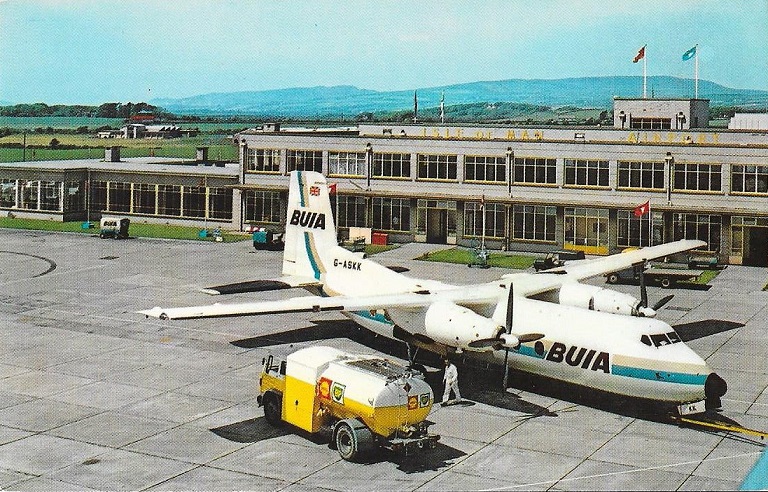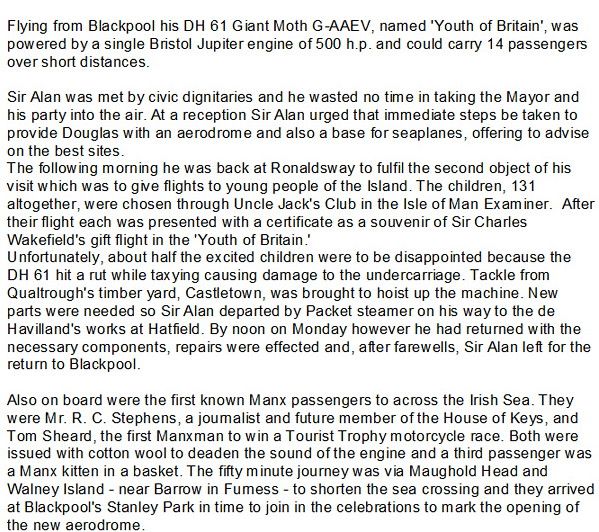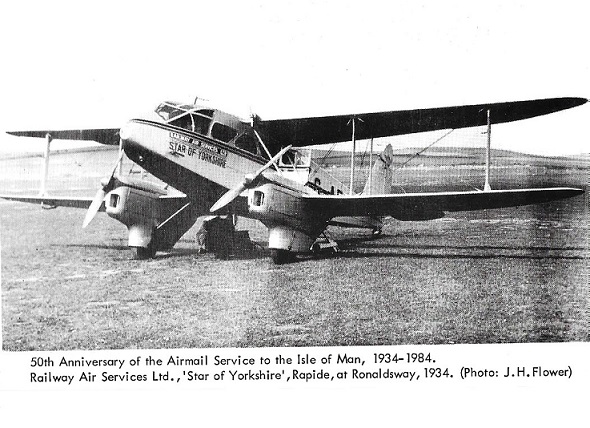Ronaldsway
RONALDSWAY: Civil regional airport then military aerodrome during WW2. Later to become the main airport for the Isle of Man
(Aka ISLE OF MAN AIRPORT & BALLASALLA AIRPORT & CASTLETOWN)
Note. This map was sent to me by a friend without telling me the source - and, years ago - I didn't think to ask. But, it is useful as it clearly shows the location of RONALDSWAY (ISLE of MAN) airport to both Ballasalla and Castletown, by which names this site has been known by over the years. The Google Earth © view was kindly provided by Mike Holder.
ICAO code: EGNS IATA code: IOM
Military users: WW2: Initially a RAF Air Firing School (Harts, Gauntlets, Lysanders, Masters & Wallaces)
The Royal Navy (HMS URLEY) moved in during 1943 and built four hard runways.
Torpedo working up station, dive-bombing and reconnaissance
710, 713 & 747 Sqdns (Barracudas and Martinets)
Post WW2: 710, 713 & 743 Sqdns (Barracudas)
Operated by: 1947: Tynwald (I.O.M Government))
1948 to 1965 at least: Isle of Man Airports Board
1980s to 1990s: Isle of Man Government Dept. of Highways, Ports & Properties
2000: The Isle of Man Government Department of Transport – Airports Division
Activities: Post 1945: Airline, air freight, charter and air taxi, GA private
British airline users: Pre 1940: Air Commerce, Amphibious Airlines, Blackpool & West Coast Air Services, Blackpool and North West Airlines, Isle of Man Air Services, Hillman’s Airways, Manx Airlines, Manx Airways, Midland & Scottish Air Ferries*, Northern Airways, Railway Air Services, Scottish Airways
Note: In the 1957 edition of the The Aeroplane directory, their fleet was given as two Bristol 170 Wayfarers, two DH114 Herons and three DH89A Draon Rapides. Services ran in conjunction with BEA were to Glasgow (RENFREW), CARLISLE, NEWCASTLE, NEWTOWNARDS and STRANREAR. The latter being of special interest, as presumably they were using CASTLE KENNEDY?
WW2: Limited operations to WOODVALE and SEALAND for example mainly by DH.89 Dragon Rapides. (G-ACYR, G-AEAL, G-AERZ, G-AFEP, G-AFEZ, G-AGLP and G-AGSJ) Operated by Railway Air Services?
Notes: I am much indebted to Neil Maxwell for identifying the first picture of Ronaldsway in the 1930s which came from the John Stroud Collection.
The second rather poor quality picture, sent by a friend copied from a magazine article, (source unknown?), shows the dominance of the DH.89A Dragon Rapide. At that time the Dragon Rapide being the airliner of choice for many airlines operating regional services. But, also in the picture can be seen Avro XIXs, (known as Ansons by the RAF), and Airspeed Consuls, (known as Oxfords in the RAF). Without too much doubt the latter two types were civilianised ex-RAF aircraft. Also in this picture, if you look closely enough, are a Miles Gemini and a Miles Aerovan.
The third picture by J Arthur Corlett, (also of poor quality but no fault of his as it has possibly been copied a few times), is of a British European Airways Pioneer Class Douglas DC-3 Dakota. A type which first started operating here regularly after 1951. Beyond it is an Aer Lingus Dakota, and they began flying in, it appears, as early as 1948.
The fourth picture is a scan from a postcard - a limited edition of 1,000 - and the photographer was Alan Kelly. The caption states that; "Manx Airlines G-OJET came into service in December 1987" so possibly this dates the picture? It also states that the BAe 146 ".....operates the Isle of Man to London route." Having checked my HEATHROW listing, it appears that Manx Airlines used that London airport. Manx Airlines ceased operations in 2002.
British Airline users - Post 1945: A2B, Air Commerce, Air Navigation and Trading, Air UK, Autair, BEA, British Airways (BA), British Island Airways, British Midland Airways, Cambrian Airways, Comed Aviation (Comex), Dan-Air, Derby Aviation, Derby Airways, Don Everall (Aviation), Eastern Airways, easyJet, Emerald Airways, Flybe, Gill Aviation, Isle of Man Air Services, Irish Sea Airways (?), Jersey Airlines (?), Jersey European Airways, Lancashire Aircraft Corporation, Lancashire Airways, Linksair, Mannin Airways, Manx Airlines, Manx2, North West Airlines (I.O.M), Olley Air Services, Scottish Airlines, Silver City, Thomas Cook
Foreign airline users: Pre 1939: Aer Lingus
Post 1945: Aer Arran, Aer Lingus, West Air Sweden
Air freight: Pre 1940: Blackpool and West Coast Air Services
Post 1945: Datapost (Chartered from?)
Charter, air taxi: Post 1945: Air Charter Experts, Air Condor, Airwork, BKS, Blue-Line Airways, British Island Airways, Derby Aviation, Lancashire Aircraft Corporation, Lockwood Flying Services, Manx Air Charters, Northern Air Charter, North West Airlines, Patrick Aviation, Silver City, Starways, Ulster Aviation
Flying club/schools: Post 1945: Ashley Gardner School of Flying, Manx Flyers Aero Club
1959 ‘snapshot’. Isle of Man Flying Club
Helicopter ops: Manx Flyers Aero Club
Location: E of A8, N of A12, NE of Castletown Bay, NW of Derby Haven, 6nm SW of Douglas
Period of operation: 1929 to present day, (other sources say 1933, I suspect the 1929 mention was actually HALL CAINE/RAMSEY?). Officially opened in 1934. Reverted to civil use after WW2 in 1946
Runways: 1930s: NE/SW 512 grass NW/SW 512 grass
WW2: 04/22 914/27 hard 09/27 1280x27 hard
18/36 914x27 hard 12/30 914x27 hard
NOTE: Keith Hayward of the British Airways Archive and Museum Collection kindly sent me this map of H.M.S. URLEY (Royal Naval Air Station - Ronaldsway) prepared in November 1948 by the Officer in Charge of Works which contained a couple of interesting points. All the runways appear identical to those in use during WW2 except that runway 12/30 was now 13/31 and runway 18/36 was both listed and shown on the drawing as “Runway 00/18”. I am fairly certain this is the only example I have come across of a runway being designated as “00/18”.
Could it be that the Officer in Charge of Works issued instructions to paint “00” on the southern end of this runway? If so it would almost certainly be unique? Or - was it?
Note: These maps are reproduced with the kind permission of Pooleys Flight Equipment Ltd. Copyright Robert Pooley 2014.
1961: 04/22 1078x 46 hard 09/27 1585x46 hard 18/36 914x27 hard 13/31 914x27 hard
1965: 04/22 1255x46 hard 09/27 1585x46 hard 18/36 914x27 hard
1990: 04/22 1266x46 hard 09/27 1753x46 hard 18/36 903x27 hard
2000: 03/21 1255x46 hard 08/26 1753x46 hard 17/35 903x27 hard
A MIKE CHARLTON GALLERY
This fabulous collection of pictures from postcards were sent by Mike Charlton who has an amazing collection. See, www.aviationpostcard.co.uk
Notes: First picture: Although painted as 'West Coast Air Services' these DH84 Dragons were, without much doubt, registered to Blackpool & West Coast Air Service. The one we can identify, G-ADCR, certainly was and served from 06.03.35 until 01.01.39. When presumably it was impressed for military service?
Second picture. An apron view showing a DH89 Dragon Rapide, a DH86 Express and just peeking out, a DH84 Dragon. Could somebody kindly advise on the Dragon Rapide and Express operators?
Fourth picture: The older and second DH80A Puss Moth G-AAXT was registered to The Hon. Brian Lewis and based at Aldenham Aerodrome - now ELSTREE. However, the newer and closer Puss Moth G-ABDI was registered to the Redhill Flying Club.
Can somebody kindly identify the biplane which is next in line. I know I should be able to identify this aeroplane - but my mind has gone blank.
Fifth picture: I have tried, without success, to try and establish when this terminal opened. I suspect in the late 1940s but advice will be most welcome. On the apron (L to R) is a Douglas DC-3, DH86 Express and a DH89A Dragon Rapide.
Sixth picture:I'm pretty certain this is a BEA (British European Airways) Douglas DC-3 Dakota, with a DH89a Dragon Rapide sticking its nose in. However, by comparing this picture with the previous picture, it seems clear that this was taken before the new terminal opened. Therefore, I suppose, not too long after WW2 ended?
Tenth picture: The Bristol 170 MK.21 Wayfarer was an airliner version of the 'Bristol Freighter' and this example, G-AIMH, has I think, a rather interesting history. It appears it was initially registered with the Ministry of Civil Aviation from the 3rd December 1946 until the 9th December 1948. I wonder what function it performed during these two years? It then went to France registered as F-BECT. I looked this up on the French aircraft register, but it isn't listed. In fact only one 'F-B' registration appears between 'F-A' and F-C'. Another mystery.
Returning to the UK, Silver City Airways operated it from the 1st April 1952 until the 6th November 1961. But as a Wayfarer I wonder, or as a 'Freighter' car transporter? Three days later it was registered to Manx Airlines but just over a year later, on the 21st December 1962, it was PWFU - Permanently Withdrawn From Use. So, it appears that this picture was taken in 1962. I imagine any Health and Safety people today will be having conniptions seeing this picture, regarding passenger management on an airport apron.
Twelth picture: This Vickers 701 Viscount, G-ANHF, was one of the first to enter service with BEA (British European Airways) and was initially registered to Vickers-Armstrong from the 12th December 1953 to the 21st June 1955. Presumably for development and route proving etc? It served with BEA from the 28th June 1955 until the 25th July 1963, afterwards going to Brazil.
Thirteenth picture. This aerial view shows, on the apron, a BEA Viscount, a Douglas DC-3 and presumably a Manx Airlines Bristol 170 Wayfarer?
Fifteenth picture: The Viscount G-AMOH was also one of the first production batch built at WEYBRIDGE, and like G-ANHF above was registered to Vickers-Armstrong from the 3rd May 1952 until to 23rd July 1953. It was registered to BEA from the 28th July 1953 to the 30th January 1964. It was then operated by Channel Airways (SOUTHEND) from the 3rd February 1964 until the 6th October 1965.
Finally it went to Cambrian Airways at GLAMORGAN (RHOOSE) AIRPORT, now CARDIFF INTERNATIONAL, from the 21st October until the 1st September 1972 when it was PWFU (Permanently Withdrawn From Use).
Sixteenth picture: Here again this BEA Viscount G-AMOL was also registered to Vickers-Armstrong initially, from the 28th May 1952 until the 8th December 1953. I had suspected a 'block booking' for a production batch, but no, the dates don't marry up - see G-AMOH above. Can anybody kindly provide an explanation?
It was registered to BEA from the 12th December 1953 until the 1st April 1963. It then went to Cambrian from the 1st of April 1963 until the 20th of July 1965 when it was destroyed in a horrendous crash on finals to Runway 26 at LIVERPOOL whilst on a positioning flight from RONALDSWAY with just two pilots on board. The aircraft suddenly rolled onto its back and dived into a factory.
A once very good friend of mine, the late Austin J Brown, used to fly this aircraft for Cambrian and he told me that the most probable cause was the flaps on one wing either retracting or, perhaps more probably breaking away, resulting in it rolling very quickly. And far too low, and suddenly for the pilots to do anything about it.
Seventeenth picture: This postcard picture is 'colour tinted' over a black & white photograph. A popular technique used before colour film reproduction became available and economical. Clearly this picture was taken shortly after the B&W version in 'Tenth Picture' listed above. Which includes more details of G-AIMH.
Eighteenth picture. Once again this Viscount was also registered to Vickers-Armstrong from the 3rd May 1952 until the 14th January 1953. Then to BEA from the 15th January until the 28th January 1963 when it went to Cambrian from the 14th February 1963 until the 31st March 1976. According to the records it was then registered to British Airways from the 1st April 1976 until the 17th May 1976, when one and half months later it was PWFU, (Permanently Withdrawn From Use). The question must be asked - why? Had it perhaps reached its total airframe hours?
Nineteenth picture. Here is another example of an aircraft, (G-ASKK), with a long and convulated history - which I hope have got correct. Registered to Handley Page, which still gave their address as Claremont Lane, Cricklewood, from the 17th July 1963 to the 17th December 1963. Then it was registered in Brazil until coming back on the UK register, with Handley Page from the 19th of October 1964 until the 1st February 1965.
Then British Midland Airways acquired it from the 1st February 1965 until the 15th February 1967. Of interest I think, is that initially the address was given as DERBY AIRPORT, then EAST MIDLANDS.
After it was registered to British Island Airways, which then became British United Island Airways (both in Jersey), from the 8th August 1967 until the 8th April 1983. Finally it was registered to Air UK (Jersey) from the 8th April until the 29th Aptil 1985. Air UK was formed by amalgamating Air Anglia, Air Wales and Air Westward.
Twentieth picture: I have never seen a Cambrian Viscount wearing this colour scheme. And, the picture shows no indication of a registration. Can anybody kindly offer advice?
A MICHAEL T HOLDER GALLERY
Note: The second item was pubished in the Burnley Express on the 7th August 1929
NOTES: RONALDSWAY was the 48th venue for Sir Alan Cobham’s 1929 Municipal Aerodrome Campaign Tour. The original plan was to visit 107 venues in England, Wales and Scotland, but in the end due a couple of minor crashes, a couple of incidents and other operational problems, in the end he managed to visit 96 venues. Even so, still a quite magnificent achievement.
The aeroplane he mostly used was the de Havilland DH61 'Giant Moth' G-AAEV, a ten-seater regional airliner type, named 'Youth of Britain'. It appears that at RONALDSWAY he had one of his mishaps, damaging the undercarriage. Arriving on the 2nd August, the mishap occurred on the 3rd August and repairs had been made by the 4th. He departed on the 5th August to arrive at
It appears Cobham recommended that RONALDSWAY should be developed rather than HALL CAINE. According to Ian D Wallis the use of a field later to become RONALDSWAY dates back to 1933 when Captain John Higgins arrived from Liverpool in a DH60 Gipsy Moth. It seems both he and Captain Olley pioneered the earlist services to RONALDSWAY in 1934 using a DH.83 Fox Moth.
As pointed out elsewhere the real history of British aviation is almost obscured by myth, legend and very often – downright lies. Quite why so many people seem determined to fog, muddle and deliberately obscure aviation history has yet to be explained. If I now have the story correct the aerodrome at RONALDSWAY was first used in 1929 but it wasn’t until July 1933 that Blackpool & West Coast Air Services established a regular service, linking Liverpool (SPEKE) which had just opened, via Blackpool (SQUIRES GATE). The initial fleet was the DH84 Dragon G-ACGU plus two DH83 Fox Moths, G-ACFC and G-ACFF.
*There is an element of guesswork as to whether Midland & Scottish Air Ferries initially used RAMSEY (HALL CAINE) as their newspaper freight service to the Isle of Man from HOOTON (CHESHIRE) and SPEKE (LANCASHIRE) began on 12th July 1933. RONALDSWAY officially opening in 1934 of course. After 5th August 1933 these flights also called in at Blackpool. (STANLEY PARK or SQUIRES GATE?)
What does seem fairly certain is that when Midland and Scottish Air Ferries ceased operations on the 14th July 1934, two days later Hillman’s Airways took over the MSAF service from London (STAPLEFORD) – Liverpool (SPEKE) – IoM – Belfast (ALDERGROVE), they landed at RONALDSWAY which had no facilities. To quote from The Triple Alliance by Neville Doyle: “It had been used by B&WCAS for regular services since the previous year, although the landing run was limited to about 560 yards. (My note; in both SW/NE and NW/SE directions). The only facilities for passengers were provided by the nearby Derbyhaven Hotel and there were no hangars. ‘If it required to leave a machine there for several nights, it is necessary to arrange for local hands to erect a barbed wire fence round the aeroplane in order to keep off the cattle’ (Flight, July 27th 1934). The problem of cattle eating the fabric on aircraft persists to this day. Writing in 2013 I can remember an enquiry, not so long ago, asking for a quote to move an aircraft from a site in the Forest of Dean (GLOUCESTERSHIRE), which had been partially devoured by cattle.
NORTHERN AIRWAYS
Northern Airways only appears to have operated from the 1st August 1934 to the 30th September using the DH.84 Dragon G-ACFG. Based at CRAMLINGTON (NORTHUMBERLAND) they routed via Carlisle (KINGSTOWN) in CUMBERLAND. However, having now read The Triple Alliance by Neville Doyle he states: “From August 1st, a regular daily service was flown - .but this was reduced to thrice weekly on August 23rd, and to twice weekly through September and October when the service ended.”
Trying to ascertain exactly where these airlines operated into (and when) just within the UK is something I do now find interesting in a sort of amateur sleuth sort of way. What really interests me is that this is quite recent history so you might well think there should be no debate – records exist yet accounts so often vary. Why is this? One aspect of simply producing a ‘Guide’ is that it is impossible to reproduce all the astonishing detail provided by so many authors. All I have tried to do is ‘cherry pick’ the basic elements.
MORE NOTES
In 1935 Railway Air Services commenced a freight and mail only service with the DH.84 Dragon G-ACXI linking Manchester (BARTON) with Belfast (ALDERGROVE) via RONALDSWAY.
Listed as being a Landing Ground in the 1930s ‘A.A. Register of Landing Grounds’.
THREE BONUS PICTURES FROM MIKE CHARLTON
In October 2018 Mike very kindly sent me these three extra pictures.
First picture: The caption on this postcard in totally incorrect. Indeed, G-AEAL was not registered until the 25th April 1936, being one of six Dragon Rapides registered to Railway Air Services from March to May that year. It went on to stay on the Isle of Man transferring to Isle of Man Air Services on the 19th October 1937 until the 29th of May 1946.
This being a good example of several regional airliners that were not impressed into military service during WW2, most of the others serving throughout Scotland. G-AEAL then had several owners in the UK before being sold to France as F-OAUE in April 1956.
Second picture: The DH84 Dragon G-ACGU was registered on the 1st June 1933 and served with Blackpool & West Coast Air Services based at SQUIRES GATE (Blackpool). It crashed at HESTON (LONDON) on the 16th July 1935 and was written off.
Third picture: Another view of G-AEAL - this time the caption being correct.
AFTER WW2
After WW2 Aer Lingus operated a DH.86 EI-ABK into RONALDSWAY and Railway Air Services, (later to become part of BEA), operated Junkers Ju 52s (Jupiters). It seems hard to believe today, doesn’t it? Later, when airline traffic after WW2 became established, the most common airliner types landing here were, up till 1954; Airspeed Consuls (civilian version of the Oxford), Avro XIXs (civilian version of the Anson, Bristol Wayfarers, DH Dragon Rapides, Douglas Dakotas, Miles Marathons and possibly BEA Vickers Vikings? It is said that BEA didn’t regularly use their Pionair Class Dakotas on the ‘Manx’ route until 1951 and the first BEA Viscount service from Manchester, (RINGWAY), arrived in July 1954
An aerial photograph I have seen, taken in May 1949, clearly shows that RONALDSWAY was a popular destination although nothing larger than a Rapide, Consul or Avro XIX can be seen, not even a ‘Dak’ which somewhat surprises me. Altogether twenty one of these ‘regional’ airliners are parked on the apron or on the grass around the ‘terminal’ and control tower situated between the ends of runways 36 and 31 on the south side of the aerodrome/airport.
BRITISH EUROPEAN AIRWAYS etc
In 1959 BEA were operating services from/to here, including: Liverpool (SPEKE), Manchester (RINGWAY), Belfast (NUTTS CORNER), and LONDON AIRPORT. Aer Lingus were flying to both Dublin and Glasgow (RENFREW) and Silver City to Blackpool (SQUIRES GATE), Birmingham (ELMDON), Leeds (YEADON), Newcastle (WOOLSINGTON), Glasgow (RENFREW), Edinburgh (TURNHOUSE) and Carlisle (CROSBY-on-EDEN). Derby Aviation were flying to Derby (BURNASTON) and Scottish Airlines to PRESTWICK.
I have discovered in doing this research that the history of British airlines is utterly fascinating, and far more varied and complex than I could have ever imagined. The ISLE of MAN being a very good example. I had no idea so many airlines would compete compete to provide a service to such a small island. The big question being WHY? The island is of course a tax haven so that must attract passengers not too much concerned over the cost of tickets and whom are therefore very attractive customers, obviously. But then again tourist traffic must be limited in numbers and very seasonal. I’d much appreciate an explanation. For the history of British airlines I would highly recommend the CD produced by Air Britain, Airlines of the British Isles since 1919 by Maurice J Wickstead.
MORE NOTES
In late 1976 when British Midland were going through a period of horrendous problems they suspended their Viscount services to RONALDSWAY from EAST MIDLANDS and Birmingham (ELMDON) and Dan-Air took the service over using Hawker-Siddeley 748s. Today the Vickers Viscount is heralded as the most successful British airliner ever, which it was, but the Avro 748 barely seems to register. It was in fact a damned good aeroplane and achieved considerable export success. But, one cannot but wonder – if supported by the British government (as the French government did with Airbus) just how much more successful it could have been?
It is a sad fact of life that the higher echelons of British government and the Civil service still have (mostly) no idea whatsoever about business, about trade, about commercial realities. And indeed, historically, (perhaps mostly during the Victorian era?) the very idea of being involved in ‘trade’ was seen as demeaning. This is a smoke-screen of course because most aristocratic and influential major mercantile British families had been up to their necks, for example, in drug-running, slavery and piracy since the 16th century at least.
Being a tad mischievous in 2006 Pilot magazine listed the ISLE of MAN as being in Scotland! And, I noticed another odd thing in their ‘Where to fly’ list of UK flying schools. Normally only those schools offering rather exotic types put, “price on application” but at RONALDSWAY the Ashley Gardner School of Flying applied this proviso to all the aircraft they claimed to operate. Including two Cherokee 140Ds, (diesel?), a Cherokee 180D and- a Challenger. (I’ll have get my spotter books out to discover what a Challenger is).
A 'VIRTUAL AIRLINE'
In 2006 the ‘virtual commuter airline’ Manx2 started operating. By 2012 the fleet stood at six aircraft; 2 x Jetstream 31 operated by Links Air, 2 x Dornier D.228 operated by FLM Aviation and 2 x LET L-410 Turbolet operated by Van Air Europe. In 2012 the company had services operating to ANGLESEY (VALLEY), BELFAST CITY (SYDENHAM), BLACKPOOL (SQUIRES GATE), CARDIFF (RHOOSE), GLOUCESTER (STAVERTON), LEEDS-BRADFORD (YEADON), NEWCASTLE (WOOLSINGTON) and OXFORD(KIDLINGTON).
Nick Owen
This comment was written on: 2018-08-16 15:22:44The blue tailed Viscount in photo no 20 is in the livery of British Air Services, a BEA subsidiary formed in 1967 to manage the financial affairs of Cambrian Airways and BKS Air Services. These colours were worn by Cambrian's Viscounts and BAC 1-11s until both airlines were finally absorbed into British Airways in the early 70s and lost their independent identity.
Nick Owen
This comment was written on: 2018-08-16 15:39:55Fourth picture: The biplane next to G-AAXT is an Avro Tutor. The three other aircraft in the front row are a Tiger Moth a BA (or Klemm) Swallow and a DH.60G Gypsy Moth. The occasion could be a Manx Air Derby.
Reply from Dick Flute:
Hi Nick, Many thanks for this info. Much appreciated. Best regards, Dick
We'd love to hear from you, so please scroll down to leave a comment!
Leave a comment ...
Copyright (c) UK Airfield Guide





















